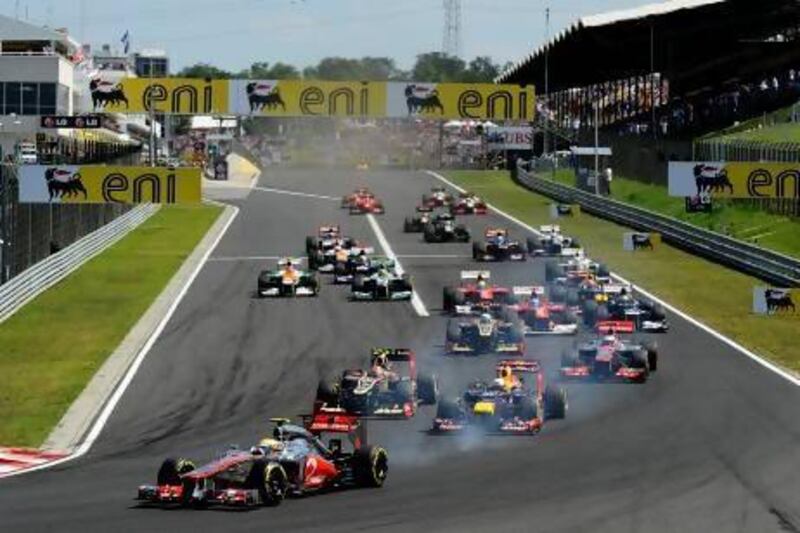Considering its longevity on the Formula One calendar there is not much love for the Hungaroring, the site of Sunday's Hungarian Grand Prix.
Since making its debut in 1986 it has been a permanent fixture on an oft-changed F1 landscape, no mean feat in consistency when you consider that only Monte Carlo and Monza, the host of the Italian Grand Prix, can boast the same achievement over the past 28 years.
So why the lack of fondness towards the race?
In simplest terms, because it only rarely delivers a good race.
Even in the modern era of quick-wearing Pirellis and the use of DRS (Drag Reduction System) it has failed to provide much overtaking, and before then it was a rarity.
The set-up of the tight and twisting 4.3km circuit is not conducive to overtaking, with only the start-finish straight offering an opportunity, and usually that still requires either a mistake from the car in front, or a substantial car advantage for a pursuing driver to stay close to his rival coming out of the sweeping right-hander to get in the slipstream quick enough in the straight to try to get a tow.
That is not to say there has not been good races.
The events of 1989, 1997, 1998, 2006 and 2011 had their moments, though the latter two do not really count as there was rain involved, which can make nearly any track interesting.
The racing is often processional, due to the aforementioned limited overtaking, and thus it is usually only the winning driver and team who leave Budapest with any degree of fondness.
That has been McLaren-Mercedes the past two years, and Hungary has been a happy hunting ground of late for them; the team has won six of the past eight races.
But the chances of the British team continuing that run on Sunday are minimal as the team's poor 2013 form means that something pretty badly wrong will have to happen to a lot of other cars for either Jenson Button, who has won twice at the venue, or Sergio Perez, to stand on the top step of the podium on Sunday.
It has been a massive fall from grace for a team who won seven times in 2012, as many as constructors' champions Red Bull Racing, but some very bad decisions on aerodynamic design has made the car too inconsistent for either driver to handle.
Neither driver has finished in the top three this season, and given Martin Whitmarsh, the team principal, has already acknowledged the team's focus is turning to ensuring the 2014 car is a more competitive creature, an upturn in fortunes before the end of the season appears unlikely.
Consequently, McLaren is in danger of failing to score a podium in a F1 season for the first time since 1980, a preposterous pre-season prospect, a tangible one mid-season one.
So who will take over as the kings of Budapest this weekend?
The forecast of a scorching-hot European weekend augur success for the three main championship contenders: Sebastian Vettel, Fernando Alonso and Kimi Raikkonen.
The Mercedes-GP pair Lewis Hamilton and Nico Rosberg will likely be on the pace in qualifying, but their cars' tendency to eat up their Pirellis quickly in hot conditions means they will likely fall away from the front of the grid as the race proceeds, an eventuality that has happened all too regularly this season.
Vettel has scant history of success at the Hungaroring; he is winless in six starts, and his best finish was second in 2011.
Vettel had never won his home race in Germany until earlier this month and the championship leader will fancy his chances of adding the Hungaroring to his long list of successful tracks.
A victory would allow him to extend a 34-point lead in his quest for a fourth successive drivers' title.
While Red Bull have improved their tyre conversation it is still an Achilles heel, and they toiled badly last time they raced in hot conditions, in Barcelona in May.
The new Pirelli compounds to be used this weekend introduce an element of uncertainty. The tyre-maker will use the 2012 design on the rear tyres in the hope of avoiding the rash of blowouts seen at Silverstone last month.
How they degrade in the Budapest heat will be an intriguing aspect of the race, or rather whose cars they last longest on.
The Lotus has usually been excellent at keeping tyres in working order for a decent period, both this year and last, and so Raikkonen and Romain Grosjean will like their chances of maintaining the form that saw them finish second and third in Germany behind Vettel, a race both men were right to feel they should have won.
Lotus went well in Hungary last year, Raikkonen the fastest man in the second half of the race, but the circuit's layout ensured he could fine no way past Hamilton, the race winner.
Qualifying will be key for the Lotuses, which too often have underperformed on a Saturday, leaving themselves too far down the grid and with too much to do on Sunday, when they have the speed to win.
Grosjean and Raikkonen qualified well in Germany and were competitive in the race, and if they can get on the front two or three rows they will be serious contenders on Sunday.
The conditions ought to favour Alonso, too, in his Ferrari, but the Spaniard's early season charge, which brought two wins in the first five races has been hurt by the next four being distinctly average.
Ferrari's progress has stalled and only the safety car's intervention ensured Alonso was anywhere near Vettel and the Lotuses at the end of action in Germany.
If Alonso cannot succeed this weekend in conditions in which he shone earlier in the year then his dreams of winning a third world title, after 2005 and 2006, likely wil1 be postponed for another year, at least.
Follow us
[ @SprtNationalUAE ]





